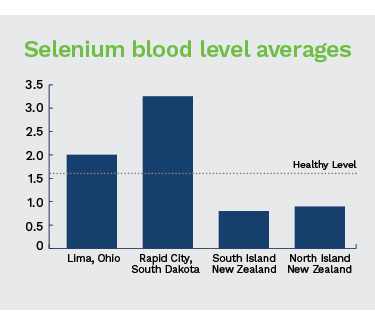This trace mineral is lacking in most New Zealand soils and is absolutely vital for our health.
The RDI (recommended dietary intake) of selenium for New Zealanders, is 60mcg daily for women and 70mcg for men.
Surveys of our RDI over the years have ranged from 28mcg to 67mcg daily, depending on the source of our bread wheat. Australian bread wheat is OK but New Zealand bread wheat is known to be low in selenium.
Selenium’s roles in protecting our health:
- Helps our daily mood remain positive and cheerful
- Greatly boosts our immunity to most cancers when our intake of iodine, chromium and natural vitamin E is adequate
- Helps rid our body of toxic minerals, especially mercury
- Boosts our immune system to fight off bacterial infections and viruses
- Helps soothe inflammation anywhere in the body and reduces incidences of asthma
- Helps maintain a healthy gut and probiotic balance
- Boosts male potency, prostate health and female fertility
- Helps maintain youthful elasticity of our arteries and skin
- Helps maintain pain free muscles
- Helps regulate blood pressure and prevents clotting
- As a powerful antioxidant, it slows down ageing and protects against cataracts
- Helps protect a mother’s health during pregnancy, her unborn children from malformities and improves survival of newborns
- Assists thyroid functions
- Needed by iodine, chromium and vitamin E to carry out their vital functions
Comparison of selenium blood test results in USA and NZ
A very high amount (78%) of older New Zealand women tested low in selenium blood tests, and 64% of older men.
In the USA, Lima, Ohio has the lowest average selenium blood test results at 2.0 µmol/L, and Rapid City, South Dakota has the highest at 3.25 µmol/.
Rapid City has only half the cancer rate of Lima, and this pattern is seen worldwide. The higher the intake of selenium, the lower the risk of cancer and many other health disorders.
Average New Zealand selenium blood test figures are 0.8 µmo/L South Island and 0.9 µmol/L North Island, less than half the lowest figures (Lima, Ohio) in the USA.
To obtain healthy selenium blood test figures, nutrition researchers recommend taking 150mcg to 175mcg of selenium daily.

Impressive cancer study results
Dr Richard Donaldson of St Louis Veteran’s Hospital, reported remarkable cancer healing results to the National Cancer Institute in 1983. He had 140 certified terminally ill cancer patients. All were found below the recommended blood selenium levels. More than 100 survived and all had reductions in tumour size and pain. Some required 200mcg to 600mcg of organic selenium a day for a few weeks to bring them up to normal blood levels. Others needed over 900mcg a day.
During an eight year population study of 10,000 Swedish men aged 46-48 years, by Malmö General Hospital, 61 died from cancer. Based on the blood selenium samples taken at the beginning of the study, it was calculated that the risk of cancer death was 3.8 times higher in the lowest selenium blood group, compared with the highest.
Main forms of selenium
Selenomethionine - The main form of organic selenium is found in brazil nuts, cereal, beans and fish. It is retained the best in our body and is the form commonly used in high quality supplements. Selenium content in eggs is 100% higher in laying hens fed selenomethionine than hens fed the normal livestock supplementary selenium, sodium selenite. Selenomethionine helps rid our body of mercury found in fish like tuna, or leached from amalgam tooth fillings.
Methylselenocysteine - The main form of organic selenium found in onions, garlic, broccoli and cabbage. This is the most effective selenium for protection against cancer, but is not retained for long in the body.
Selenate - The main form of organic selenium found in shellfish and vegetables apart from onions, garlic and broccoli. It is absorbed well initially, but large amounts are soon expelled in your urine. This is also an effective cancer protector.
Sodium selenite - A non-organic selenium used mostly in livestock health supplements. Farmers have reported that it protects against cancer in both animals and humans, including skin cancer on their hands and it also reduces nocturnal urination. Only about half is absorbed however, but it appears to be more active than the organic selenium types already mentioned. High doses can be toxic, producing a garlic-like breath.
Selenium enriched yeast - An organic selenium grown in a yeast medium that contains inorganic selenium (usually selenite). If grown carefully, a tiny proportion of the yeast (about 0.05%) will contain a mixture of the organic seleniums listed (but mostly selenomethionine). Although expensive, this selenium has proven very effective in health studies. However, it is impractical for inclusion in a multivitamin as 99.09% of it is yeast and it takes up too much space in an already crammed capsule, but can be found in specialised selenium products.
Selenium disulphide - A form of selenium toxic to humans, but kills bacteria and is used in anti-dandruff shampoos and treatments.
Low toxicity of organic selenium
In numerous scientific studies to date, no organic selenium has been found toxic, even up to an intake of 800mcg daily over a period of years. However, the non-organic livestock selenium, sodium selenite can be toxic and should not exceed 400mcg a day, if taken on a regular basis.
If you decide to have your blood level of selenium tested, expert UK selenium researcher Professor Margaret Rayman recommends at least 1.6 µmol/L as a healthy level.